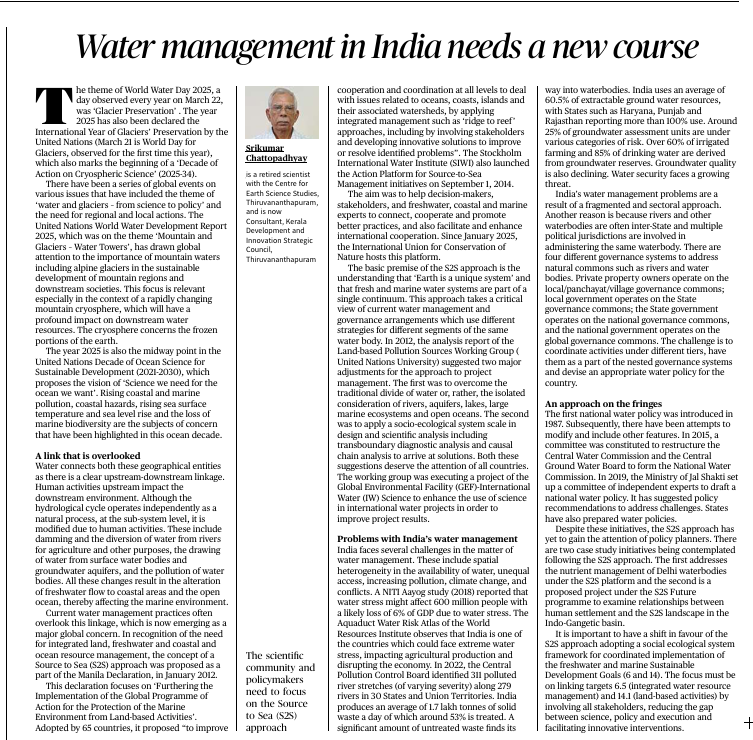- Global Context: World Water Day 2025
- Theme: Glacier Preservation — highlighting mountain glaciers as vital freshwater sources.
- Linked Global Efforts:
- UN Water Development Report 2025: Focus on “Mountains and Glaciers – Water Towers”.
- Importance of cryosphere and sustainable development of upstream/downstream ecosystems.
- UN Water Development Report 2025: Focus on “Mountains and Glaciers – Water Towers”.
🔄 2. Need for an Integrated, Upstream-Downstream Approach
- Human interventions (e.g., damming, diversion, pollution) disrupt natural hydrological cycles.
- Current Indian challenges:
- Fragmented, sectoral water governance.
- Lack of coordination between agencies managing rivers, groundwater, and ecosystems.
- Jurisdictional overlaps between Centre, States, and Panchayats.
- Fragmented, sectoral water governance.
💡 3. Source to Sea (S2S) Approach: A Sustainable Alternative
- Recognizes interconnection of rivers, lakes, groundwater, estuaries, oceans as one system.
- Promotes:
- Scientific and socio-ecological diagnosis.
- Participatory management with local communities.
- Nature-based solutions over hard infrastructure.
- Scientific and socio-ecological diagnosis.
🚨 4. Problems in India’s Current Water Management
- Water stress & inequity: 60 crore Indians face high to extreme water stress.
- Declining groundwater: >60% of irrigation and 85% of drinking water use groundwater.
- States like Punjab, Rajasthan, Haryana use >100% of their groundwater annually.
- Poor treatment of urban wastewater: ~40% of wastewater untreated.
- Heavy reliance on private water provisioning due to failed public systems.
🛠️ 5. Reforms and Policy Shifts Needed
- Previous policy attempts:
- National Water Policy 1987, 2002, 2012 – largely ineffective.
- 2015 restructuring of Central Water Commission & Central Ground Water Board.
- 2019 Jal Shakti Ministry proposed a national framework.
- National Water Policy 1987, 2002, 2012 – largely ineffective.
- However, coordination, legal clarity, and a systems approach are still missing.
🔑 6. Key Recommendations
- Adopt S2S Framework at national/state levels.
- Integrate land-ocean-freshwater systems.
- Shift to ecosystem-based management and nature-positive development.
- Encourage community engagement and multi-stakeholder governance.
- Promote scientific tools for risk mapping, adaptive management, and policy diagnostics.
✅ 7. Takeaway
- India needs a paradigm shift in water governance—from fragmented, supply-centric policies to integrated, ecologically rooted water systems
- The S2S approach offers a scientific, inclusive, and sustainable pathway to tackle India’s water crisis.
10-Marker (150 words)
Q1. “Water management in India suffers from a fragmented and sectoral approach.” In this context, explain the relevance of the “Source-to-Sea” (S2S) framework for sustainable water governance.


